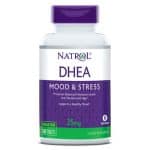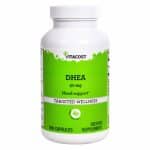DHEA may provide benefits to aging individuals. Restoring a young adult DHEA level seems beneficial in cases of age-related decline in physiological functions.
How DHEA May Have Anti-Aging Effects
It is clear that lifelong maintenance of high DHEA levels combined with low cortisol levels is an effective anti-aging strategy. And the easiest way to maintain high DHEA levels from the age of 30 is to take a DHEA supplement.
As part of an overall approach to fighting the diseases of aging, people should monitor their blood levels of DHEA and strive to replicate the hormone levels of a healthy 21 year old. Fortunately, DHEA is well tolerated as a supplement, with minimal side effects, even at relatively high doses.
Restoration of a young adult DHEA level appears beneficial in cases of age-related decline in physiological functions.

Clinical studies
A study links aging to DHEA levels in men.
A new study reveals very interesting information about the importance of DHEA.
Conducted in southwestern Japan over a period of 27 years, the Tanushimaru study, as it is called, analyzed the link between longevity and levels of DHEAS (sulfated form of DHEA) in blood serum. This study, the largest and longest conducted to date, observed 940 subjects, aged 21 to 88, beginning in 1978. Participants underwent a comprehensive medical examination, which included measurement of serum DHEAS levels. The researchers followed the subjects until the end of 2005. After weighting for factors such as age, blood pressure and blood glucose level, the study showed a strong correlation between DHEAS levels and mortality in topics.
Those with a DHEAS level of less than 129 mcg/dL at the start of the study had a mortality rate of 25%, while those with a level above 200 mcg/dL had a mortality rate of less than 9% . If there is a link between DHEAS levels and longevity in men, how come the Tanushimaru study was the first to find it? The researchers found that the benefit of having a high level of DHEAS did not appear until 15 years after the start of the study. As all other previous studies were shorter, this may explain why the Tanushimaru study was the first to discover such a link.In his book “The Anti-Aging Zone”, B. Sears indicates that the age-related increase in insulin level/insulin resistance is the main culprit of aging. Similarly, Dilman and Dean, in their seminal work "The Neuroendocrine Theory of Aging and Degenerative Diseases" also consider age-related disorders of glucose and insulin metabolism to be the primary culprits of aging. and degenerative diseases. A growing body of evidence indicates that DHEA plays a significant role in reducing age-related insulin resistance, blood insulin levels and blood glucose levels.
In 1995 Jakubowicz, Beer and Rengifo published their results of a 30-day, double-blind, placebo-controlled study of 22 57-year-old men who took 100 mg of DHEA every night. Their serum insulin reading went from 35.3 to 25.8 mU/ml, while the glucose reading went from 93.4 to 88.9 mg/ml.
Rates were virtually unchanged for the placebo group.In 1996 a group led by C. Berr and EE Baulieu (the pioneer of DHEA research) published the epidemiological results of a 4-year study of 622 subjects over 65 living in rural areas in France. Among the 356 women evaluated, limitation of daily activities, confinement to bed or home, dyspnea (shortness of breath), depressive symptoms, were significantly correlated with a high level of DHEAS. In addition, these people felt healthy, were satisfied with their lives and used less medication.
For the 266 men in the study, only feelings of well-being and less use of medication were linked to high DHEAS levels. It is clear that for the women in this study, having a high level of DHEAS is linked to feelings of well-being and quality of life.Preliminary studies also suggest that external use of DHEA may have an anti-aging effect on the skin.




